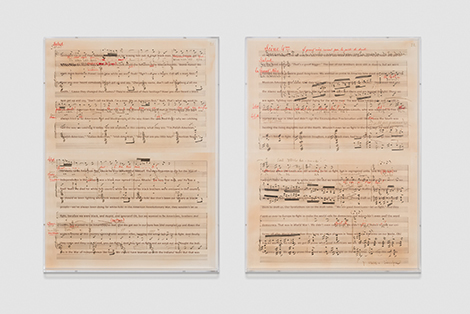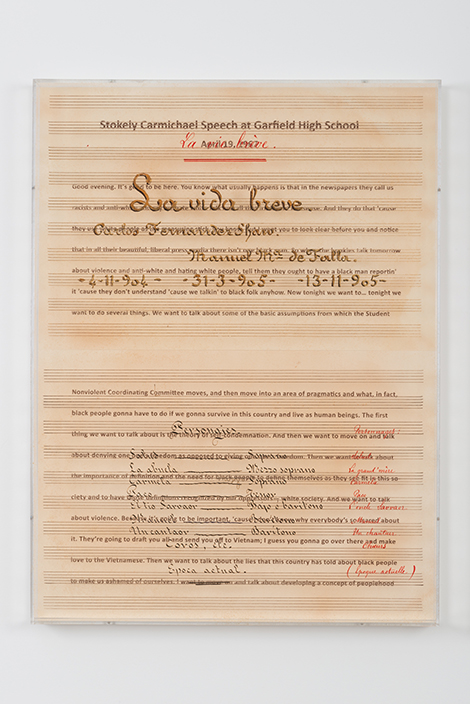The first exhibition at Art+Practice, which recently opened in the historic Leimert Park district, is a site-specific installation by veteran conceptual artist, Charles Gaines. “Librettos: Manuel de Falla/Stokely Carmichael” (2015) consists of 23 acrylic box frames floating the score of Spanish composer Manuel de Falla’s circa 1904 opera La Vida Breve in front of the text of a 1964 Stokely Carmichael speech. The rigorous yet poetic “Librettos” was timed to show concurrently with “Charles Gaines: Gridwork 1974–1989,” a major retrospective at the Hammer Museum, initially organized and presented by the Studio Museum in Harlem. Reading “Librettos” reveals an implosion of text, duration, language and meaning that sets up a relationship between music and language. A viewer must first look through de Falla’s libretto to read the text of Carmichael’s speech; both surfaces have been treated to replicate the appearance of oxidized paper. Here lies Gaines’ gift, to arc or make large leaps through time and space to discover overlooked revelations.
If the artist consciously intended to establish a chance equivalent between the year Carmichael delivered his speech at twenty-three years of age, and the number of “frames” Gaines uses to present the speech, this kind of numerical economy shows up as an elegant reduction, in which the libretto’s components are distilled into numerical, linear and gridded systems. Some already existed within Gaines’ source material, like a ready-made, while others were written in, like the composer Anthony Braxton’s cryptically encoded record titles. Additionally, Gaines explores methods of communication, moving laterally across visual fields (be they monitors or screens), as fragmented strips of information. Gaines cites musician/artist John Cage as a significant influence, and indirectly gives a nod to jazz drummers, such as Art Blakey and Elvin Jones. (Gaines also has a background in jazz drumming).

Charles Gaines, Librettos: Manuel de Falla / Stokely Carmichael, Set 1, 2015. Printed ink-stained paper and lightjet print on acrylic. Diptych, 36 × 27 × 3 in. each; 36 × 56 × 3 in. overall. Courtesy of the artist; Susanne Vielmetter Los Angeles Projects; and Paula Cooper Gallery, New York. Photo by Josh White.
Gaines generates active noise and passive silence in the breaks between notes and musical ideas in his staging of “Librettos,” allowing the audience to hear/see in Carmichael’s speech parallel relationships between seemingly opposing directions. Gaines establishes dialectically complimentary opposites as opposed to antagonistic negatives.
In some of his work, the artist visits and revisits justice as a running theme or subtext. A little known installation created for the California African American Museum’s 1992 exhibition “NO JUSTICE NO PEACE? RESOLUTIONS….,” Gaines’ Submerge Text, #1: Representations of Religion, Darryl Gates (excerpted from Chief: My Life in the L.A.P.D.) reveals the artist’s ethical posture and sense of justice. Gaines managed to obtain a copy of the book written by then Police Chief Darryl Gates that was blown-up on one of the museum walls. The artist set about the task of removing and eliminating words and letters, thus establishing a certain cadence and syntax within the remaining text. “Librettos” elaborates this theme, invigorating it through the sheet music of de Falla’s opera and the “lip drumming” of Carmichael’s speech. Gaines’ concern for justice reverberates throughout his elegant geometry, in which silence is inactive sound and sound is amplified silence.


